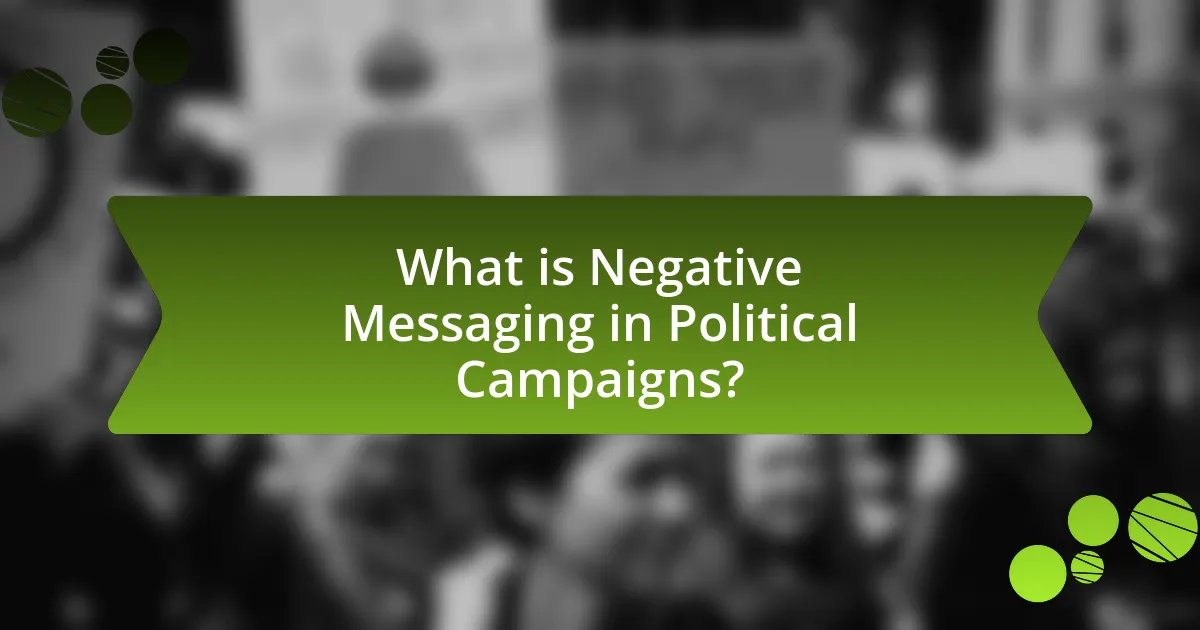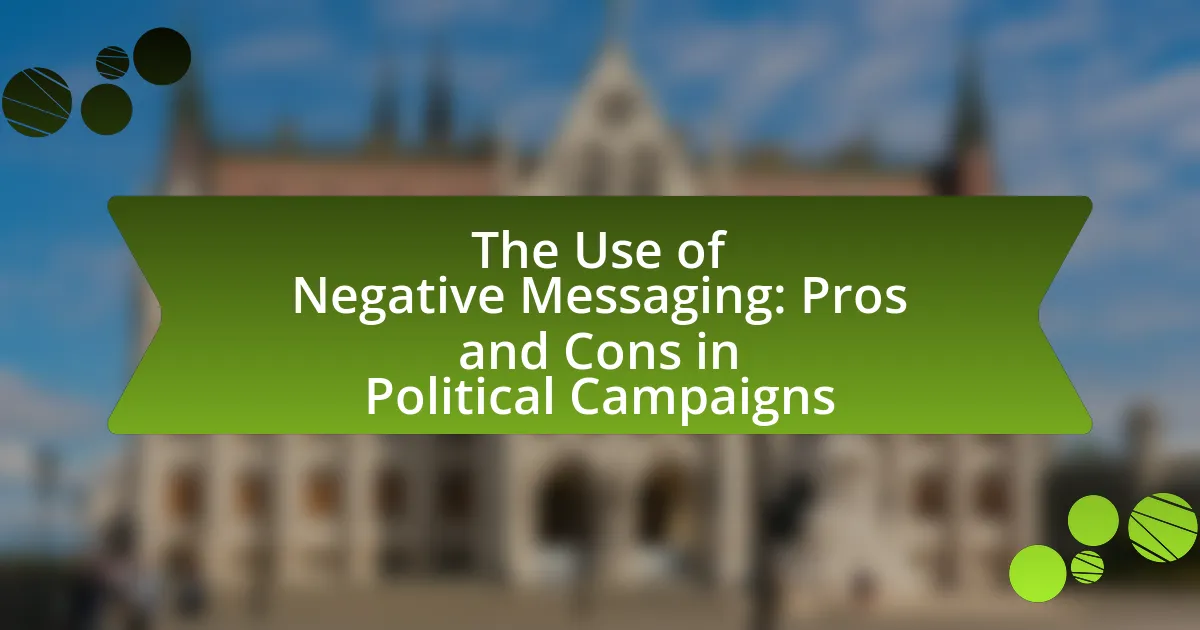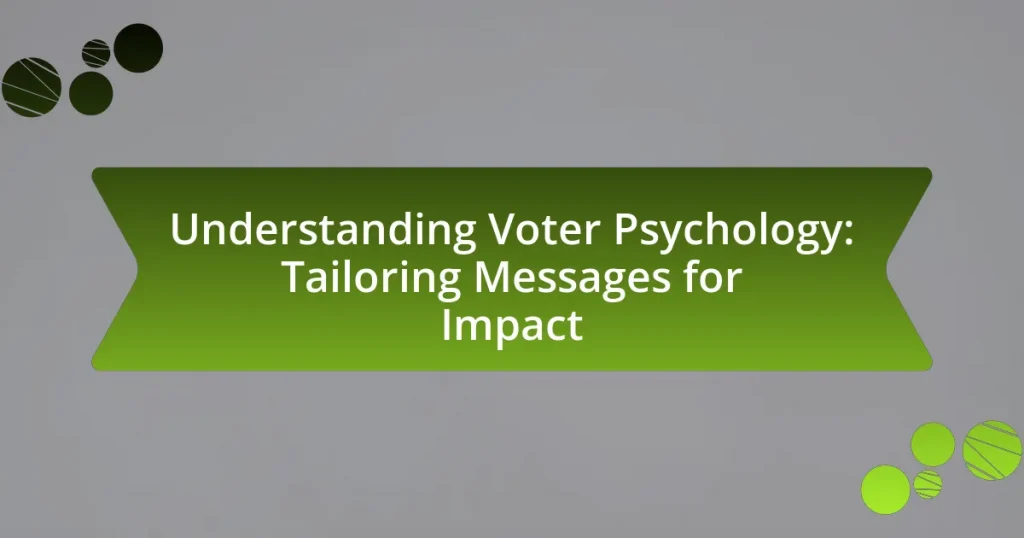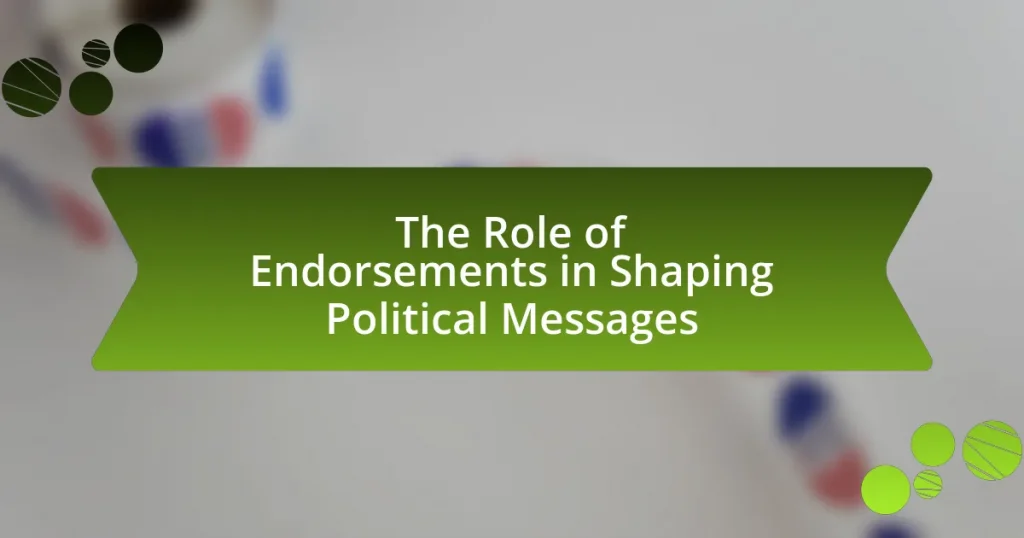Negative messaging in political campaigns refers to strategies that criticize opponents rather than promote one’s own policies. This article explores the definition, characteristics, and historical context of negative messaging, highlighting its effectiveness in influencing voter perceptions and behavior. It examines the psychological effects on voters, the differences between negative and positive messaging, and the pros and cons of employing such tactics. Additionally, the article discusses notable examples, demographic responses, and strategies candidates can use to balance negative messaging while mitigating associated risks. Ethical concerns surrounding negative messaging and its impact on voter behavior are also addressed, providing a comprehensive overview of this contentious aspect of political campaigning.

What is Negative Messaging in Political Campaigns?
Negative messaging in political campaigns refers to strategies that focus on criticizing or attacking an opponent rather than promoting one’s own policies or qualifications. This approach aims to undermine the opponent’s credibility, often by highlighting their perceived flaws, failures, or controversial actions. Research indicates that negative messaging can be effective; for instance, a study by the American Political Science Review found that negative ads can significantly influence voter perceptions and behavior, often leading to increased voter turnout and preference shifts.
How is Negative Messaging Defined in the Context of Politics?
Negative messaging in the context of politics is defined as communication that emphasizes the flaws, failures, or negative attributes of opponents rather than promoting one’s own positive qualities. This strategy is often employed in political campaigns to influence voter perceptions and behavior by creating doubt or fear regarding the opposing candidate. Research indicates that negative messaging can be effective; for instance, a study published in the Journal of Politics found that negative advertisements can significantly sway undecided voters by highlighting the perceived weaknesses of opponents.
What are the key characteristics of Negative Messaging?
Negative messaging is characterized by its focus on attacking opponents rather than promoting one’s own agenda. This approach often includes the use of fear tactics, highlighting flaws or failures of the opposition, and presenting exaggerated claims to sway public opinion. Research indicates that negative messaging can lead to increased voter engagement, as it captures attention and provokes emotional responses, but it may also foster cynicism and distrust among the electorate. Studies show that campaigns employing negative messaging can result in a 10-20% increase in voter turnout, demonstrating its effectiveness in mobilizing support.
How does Negative Messaging differ from Positive Messaging?
Negative messaging focuses on highlighting the flaws, failures, or negative attributes of opponents, while positive messaging emphasizes the strengths, achievements, and favorable qualities of a candidate or policy. Research indicates that negative messaging can evoke stronger emotional responses, leading to increased voter engagement, as evidenced by studies showing that negative ads often outperform positive ones in terms of recall and impact. For instance, a study by the American Political Science Review found that negative advertisements can lead to a 10% increase in voter turnout compared to positive messaging.
Why is Negative Messaging Used in Political Campaigns?
Negative messaging is used in political campaigns primarily to highlight the flaws or failures of opponents, thereby influencing voter perceptions and decisions. This strategy is effective because it can create a sense of urgency and fear, prompting voters to align against a perceived threat. Research indicates that negative ads can be more memorable than positive ones, as they evoke stronger emotional responses. For instance, a study by the American Political Science Review found that negative campaigning can lead to increased voter turnout, as individuals feel more compelled to vote against a candidate rather than simply for a candidate.
What psychological effects does Negative Messaging have on voters?
Negative messaging significantly impacts voters by inducing feelings of fear, anxiety, and distrust towards candidates and political parties. Research indicates that exposure to negative political ads can lead to increased voter cynicism and lower overall political engagement. For instance, a study published in the Journal of Politics found that negative campaigning can enhance the perceived threat of opposing candidates, which may mobilize certain voter demographics while alienating others. Additionally, negative messaging can create a backlash effect, where voters become resistant to the intended influence, ultimately leading to decreased support for the candidate employing such tactics.
How does Negative Messaging influence voter perception of candidates?
Negative messaging significantly influences voter perception of candidates by shaping opinions and attitudes through the dissemination of unfavorable information. Research indicates that negative ads can lead to increased voter awareness and engagement, as they often highlight perceived flaws or controversies associated with a candidate. For instance, a study by Ansolabehere and Iyengar (1995) found that negative political advertisements can sway undecided voters by creating a more negative image of the targeted candidate, thus affecting their likelihood of support. Furthermore, negative messaging can reinforce existing biases, leading voters to align more closely with candidates who are portrayed positively in contrast to their opponents. This dynamic illustrates how negative messaging not only impacts individual perceptions but also alters the overall electoral landscape.
What are the Historical Contexts of Negative Messaging in Politics?
Negative messaging in politics has historical roots that trace back to ancient civilizations, where political rivals employed slander and propaganda to undermine each other. For instance, during the Roman Republic, figures like Cicero used negative rhetoric to discredit opponents, illustrating that such tactics have long been a part of political strategy. In the 19th century, the rise of mass media allowed for more widespread dissemination of negative messages, as seen in the mudslinging campaigns of the U.S. presidential elections, notably between Andrew Jackson and John Quincy Adams in 1828, where personal attacks became a hallmark of political discourse. The use of negative messaging has evolved with technology, from pamphlets to radio and television, culminating in the digital age where social media amplifies negative political messaging, as evidenced by the 2016 U.S. presidential election, where negative ads and misinformation played a significant role in shaping public perception.
How has Negative Messaging evolved over time in political campaigns?
Negative messaging in political campaigns has evolved from simple character attacks to sophisticated strategies that leverage media and data analytics. Initially, negative messaging focused on direct personal attacks, as seen in the 1800 presidential election between John Adams and Thomas Jefferson, where mudslinging was common. Over time, particularly in the late 20th century, campaigns began to incorporate psychological tactics and emotional appeals, utilizing television and later digital platforms to reach wider audiences. The advent of social media has further transformed negative messaging, allowing for targeted ads and rapid dissemination of negative content, exemplified by the 2016 U.S. presidential election, where misinformation and negative framing played significant roles. This evolution reflects a shift towards more strategic, data-driven approaches that aim to influence voter perceptions and behavior effectively.
What notable examples of Negative Messaging have shaped political landscapes?
Notable examples of negative messaging that have shaped political landscapes include the “Daisy” ad used by Lyndon B. Johnson in the 1964 presidential campaign, which implied that Barry Goldwater’s policies could lead to nuclear war. This ad effectively swayed public opinion against Goldwater, contributing to Johnson’s landslide victory. Another significant instance is the “Swift Boat Veterans for Truth” campaign in 2004, which targeted John Kerry’s military service and credibility, significantly impacting his presidential bid against George W. Bush. Additionally, the 2016 U.S. presidential election saw extensive negative messaging, particularly through social media, where both major candidates utilized attack ads to undermine each other’s character and policies, influencing voter perceptions and turnout. These examples illustrate how negative messaging can effectively alter political dynamics and voter behavior.
What are the Pros of Using Negative Messaging in Political Campaigns?
Negative messaging in political campaigns can effectively highlight an opponent’s weaknesses, thereby influencing voter perceptions and decisions. Research indicates that negative ads tend to be more memorable than positive ones, leading to increased voter engagement and awareness. For instance, a study by the American Political Science Review found that negative campaigning can lead to a higher turnout among voters who feel strongly about the issues being contested. Additionally, negative messaging can create a sense of urgency, prompting voters to act against perceived threats, which can be particularly effective in close races.
How can Negative Messaging effectively highlight candidate weaknesses?
Negative messaging can effectively highlight candidate weaknesses by strategically emphasizing flaws or shortcomings in their policies, character, or past actions. This approach draws attention to specific vulnerabilities, making them more salient to voters. For instance, research indicates that negative ads can increase voter awareness of a candidate’s weaknesses by 20% compared to positive messaging, as they often provoke emotional responses that lead to greater retention of information. By framing these weaknesses in a compelling narrative, negative messaging can influence public perception and sway undecided voters, ultimately impacting election outcomes.
What advantages does Negative Messaging provide in terms of voter engagement?
Negative messaging enhances voter engagement by capturing attention and increasing emotional responses. Research indicates that negative advertisements are more memorable and can provoke stronger reactions than positive messages, leading to higher levels of voter interest and discussion. For instance, a study by the American Political Science Review found that negative campaigning can lead to increased voter turnout by creating a sense of urgency and concern about the opposing candidate’s policies or character. This heightened emotional engagement often translates into greater participation in the electoral process.
What are the Cons of Using Negative Messaging in Political Campaigns?
Using negative messaging in political campaigns can lead to voter disengagement and increased polarization. Research indicates that negative ads often create a backlash, causing voters to feel disillusioned and less likely to participate in the electoral process. For instance, a study by the American Political Science Review found that negative campaigning can decrease voter turnout by as much as 5%. Additionally, negative messaging can reinforce existing biases, making it harder for candidates to appeal to undecided voters. This approach can also damage the overall perception of the political system, leading to a lack of trust in politicians and institutions.
How can Negative Messaging backfire and harm a candidate’s reputation?
Negative messaging can backfire and harm a candidate’s reputation by alienating voters and reinforcing negative perceptions. When candidates employ aggressive negative tactics, they risk being perceived as untrustworthy or desperate, which can lead to a loss of support. Research indicates that campaigns focusing on negative messaging often see a backlash, as voters may respond more favorably to positive messages or candidates who promote unity. For instance, a study by the Pew Research Center found that 60% of voters prefer candidates who focus on their own policies rather than attacking opponents. This demonstrates that negative messaging can ultimately damage a candidate’s image and reduce their appeal to the electorate.
What ethical concerns arise from the use of Negative Messaging?
The use of negative messaging in political campaigns raises several ethical concerns, primarily related to misinformation, emotional manipulation, and the potential for societal division. Misinformation can occur when negative messages distort facts about opponents, leading to voter deception; for example, studies show that misleading political ads can significantly influence public perception and voting behavior. Emotional manipulation is another concern, as negative messaging often exploits fear and anger, which can undermine rational decision-making among voters. Additionally, the pervasive use of negative messaging can contribute to societal division, fostering an environment of hostility and polarization, as evidenced by research indicating that negative political discourse correlates with increased social conflict. These ethical issues highlight the responsibility of political entities to consider the broader implications of their messaging strategies.
How does Negative Messaging Impact Voter Behavior?
Negative messaging significantly influences voter behavior by increasing voter turnout and shaping perceptions of candidates. Research indicates that negative advertisements can mobilize undecided voters by highlighting the perceived flaws of opponents, thus making them more likely to engage in the electoral process. For instance, a study by the American Political Science Review found that negative campaigning can lead to a 5-10% increase in voter turnout, particularly among those who feel strongly about the issues presented. Additionally, negative messaging can create a sense of urgency and fear, prompting voters to act against a candidate rather than for one, which can alter their voting preferences.
What evidence exists to support the effectiveness of Negative Messaging?
Negative messaging is effective in political campaigns, as evidenced by various studies demonstrating its impact on voter behavior. Research by Ansolabehere and Iyengar (1995) found that negative advertisements significantly influence voter perceptions and can lead to increased voter turnout. Additionally, a study published in the Journal of Politics by Geer (2006) indicated that negative campaigning can enhance the perceived credibility of the attacking candidate, thereby swaying undecided voters. Furthermore, a meta-analysis by Lau et al. (2007) revealed that negative messages tend to be more memorable than positive ones, which can lead to greater retention of information about candidates. These findings collectively support the effectiveness of negative messaging in shaping electoral outcomes.
How do different demographics respond to Negative Messaging?
Different demographics respond to negative messaging in varied ways, influenced by factors such as age, gender, education, and political affiliation. Research indicates that younger voters tend to be more responsive to negative messaging, as they often seek authenticity and are more engaged by emotionally charged content. In contrast, older demographics may react negatively to aggressive negative messaging, perceiving it as divisive or untrustworthy.
Additionally, studies show that women are generally more sensitive to negative messaging than men, often leading to a backlash against candidates who employ such tactics. Furthermore, individuals with higher education levels may critically evaluate negative messages, leading to skepticism about their validity. A study by the Pew Research Center highlights that political affiliation also plays a significant role; individuals aligned with a party may be more accepting of negative messaging directed at opposing candidates while rejecting similar tactics aimed at their preferred candidates.
These demographic responses underscore the complexity of utilizing negative messaging effectively in political campaigns, as the impact can vary significantly across different groups.
What Strategies Can Candidates Use to Balance Negative Messaging?
Candidates can balance negative messaging by employing strategies such as reframing the narrative, emphasizing positive achievements, and engaging in direct voter outreach. Reframing involves shifting the focus from negative attacks to constructive discussions about issues, which can mitigate the impact of negative messaging. For instance, candidates can highlight their policy successes or community contributions to counteract negative perceptions. Engaging directly with voters through town halls or social media allows candidates to clarify their positions and address concerns, fostering a more personal connection that can overshadow negative portrayals. Research indicates that candidates who maintain a positive campaign tone alongside addressing negative messaging can improve their overall favorability ratings, as seen in studies conducted during various electoral cycles.
How can candidates mitigate the risks associated with Negative Messaging?
Candidates can mitigate the risks associated with negative messaging by employing strategic communication techniques that emphasize transparency and counter-narratives. By proactively addressing negative claims and providing factual rebuttals, candidates can diminish the impact of misinformation. For instance, research indicates that campaigns that engage in direct communication with voters about negative messaging can improve public perception and trust. Additionally, utilizing positive messaging alongside negative tactics can create a balanced narrative, reducing backlash. A study by the Pew Research Center found that voters respond more favorably to candidates who maintain a positive tone while addressing criticisms, thus reinforcing the effectiveness of this approach.
What best practices should candidates follow when employing Negative Messaging?
Candidates should ensure that negative messaging is fact-based, targeted, and strategically timed. Fact-based messaging enhances credibility and avoids backlash; for instance, using verifiable statistics or documented actions of opponents can substantiate claims. Targeting specific issues that resonate with voters allows candidates to connect emotionally and rationally, increasing the impact of the message. Strategic timing, such as releasing negative messages when they can dominate media coverage, maximizes visibility and effectiveness. Research indicates that negative ads can increase voter turnout by 5% when they highlight specific failures or controversies, demonstrating the potential effectiveness of well-executed negative messaging.



